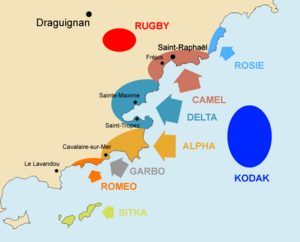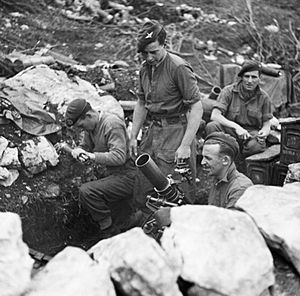2nd Parachute Brigade in Southern France facts for kids
Quick facts for kids 2nd Parachute Brigade in Southern France |
|||||||
|---|---|---|---|---|---|---|---|
| Part of Operation Dragoon | |||||||
 Map of the Dragoon landings, the airborne landings Operation Rugby highlighted in red |
|||||||
|
|||||||
| Belligerents | |||||||
| Commanders and leaders | |||||||
| Charles Hilary Vaughan Pritchard | Johannes Baessler | ||||||
| Units involved | |||||||
| 2nd Parachute Brigade | 242nd Infantry Division | ||||||
| Casualties and losses | |||||||
| 51 dead 130 wounded 181 missing ^ |
Unknown but around 350 prisoners taken | ||||||
| ^ Some of the missing later reported for duty | |||||||
In August 1944, the British 2nd Parachute Brigade took part in a special airborne mission called Operation Rugby. This mission was part of a bigger invasion called Operation Dragoon. The goal of Operation Dragoon was for American forces to land in Southern France.
The paratroopers landed in the River Argens valley. Their job was to stop German soldiers from reaching the beaches where the main invasion was happening. Most of this operation involved American troops. The British 2nd Parachute Brigade was the only British unit taking part.
Even though the brigade's pathfinders landed exactly where they should, many other paratroopers landed far away. Some were as far as 20 miles (32 km) off target. The gliders carrying heavy equipment also faced problems. Bad weather forced some anti-tank units to turn back to Italy. Despite these issues, the brigade captured its main targets. Because they had fewer soldiers than planned, American forces helped capture other areas. Within two days, the paratroopers met up with the soldiers who landed on the beaches. The brigade then became a reserve force.
The British had planned to leave France quickly. So, eleven days after landing, the brigade boarded ships for Italy. The operation cost the brigade 362 soldiers, either dead, wounded, or missing. But this did not stop them from their next mission in Greece two months later. Only 126 new soldiers were needed to make the brigade full strength again.
Contents
Background to the Mission
The 2nd Parachute Brigade

The 2nd Parachute Brigade was formed in 1942. It was led by Brigadier Charles Hilary Vaughan Pritchard. The brigade had three parachute battalions, plus their own artillery and engineer support.
Before this mission, the brigade had fought in Italy. They took part in Operation Slapstick, landing at Taranto. They also fought in battles at Cassino and along the Sangro river. Their only previous parachute mission, Operation Hasty, involved just sixty men.
Operation Dragoon Explained
Operation Dragoon was the code name for the Allied invasion of Southern France during World War II. This invasion happened in August 1944, between Cannes and Toulon. The U.S. Seventh Army led the landings. The French First Army would land once the beaches were safe.
After the success of the Normandy airborne landings, Allied leaders wanted to use paratroopers again. However, many experienced airborne divisions were busy or resting. The American 82nd and 101st Airborne Divisions were recovering from Normandy. The British 1st and 6th Airborne Divisions were also unavailable. Other American airborne divisions were either fighting in the Pacific or still training in the United States.
Getting Ready for Battle
The 1st Airborne Task Force
Because no full airborne division was available, the Allies created a special group. They called it the 1st Airborne Task Force. It was put together in Italy on July 1, 1944. Its main goal was to land in the River Argens valley. This was between Le Muy and Le Luc. Their mission was to stop German reinforcements from reaching the invasion beaches.
The task force included American parachute battalions. To make it stronger, the experienced 2nd Parachute Brigade joined them. However, the British brigade would only stay until the beachhead was secure. They would leave once the sea and airborne forces linked up.
The first plan for Operation Rugby (the airborne part of Dragoon) had the units spread out. This made them easy targets for German attacks. A new plan was made on July 12. This plan brought all the American units closer together. Finally, on July 15, a third plan was made. This plan placed all the drop zones near Le Muy. The 2nd Parachute Brigade would land north of Le Muy. Their job was to capture Le Muy and nearby areas like La Motte.
There weren't enough planes to carry everyone at once. So, the task force was divided into two big groups and a small British glider group. On D-Day, the first group would arrive in the morning. The second group would arrive in the afternoon. In total, over 9,000 soldiers, 221 vehicles, and 213 artillery guns would be flown into France.
German Forces in the Area
The German forces in Southern France were part of Army Group G. Many of these divisions were not well-equipped or experienced. Their soldiers were often older or not fully fit for frontline combat. Some units even had foreign soldiers forced into service.
After the Normandy landings, many German units moved north. Replacements were often weak and lacked equipment. In August 1944, the German 19th Army was in the area. The 242nd Infantry Division was specifically in the River Argens valley. This was where the 2nd Parachute Brigade would land.
Operation Rugby: The Attack
D-Day: August 15, 1944
At 3:34 AM on August 15, 1944, the brigade's pathfinders landed. Their job was to set up beacons and lights to guide the main force. By 4:30 AM, they had set up two special beacons.
When the main group of C-47 aircraft arrived around 4:45 AM, many paratroopers were dropped in the wrong places. Only 73 planes dropped their soldiers on the correct drop zone. The rest scattered their loads, some landing 20 miles (32 km) away. Brigadier Pritchard, the brigade commander, landed very close to the beacons.
The 4th Parachute Battalion had only about 40% of its soldiers. The 6th (Royal Welch) Parachute Battalion had 60%. By 6:30 AM, Brigade Headquarters was set up. They made radio contact with the American 36th Infantry Division, which was still at sea. The paratroopers, even with fewer men, headed for their targets.
The 4th Parachute Battalion quickly secured its first targets. These were high grounds overlooking Le Muy and the village of Les Serres. They fought off small German attacks all day. They also captured a bridge over the River Naturby, taking 29 prisoners. This fighting cost them seven dead and nine wounded.
Most of the 5th (Scottish) Parachute Battalion landed far from their drop zone. They formed smaller groups and worked their way back to the brigade. One group attacked a German convoy, causing many casualties. Another group met American paratroopers and headed towards Le Muy.
The scattered landings caused confusion for the Germans. Small groups of British paratroopers caused a lot of trouble. One sergeant even convinced 80 Germans to surrender by making them believe they were surrounded. Another company ambushed a convoy, killed 12 Germans, and then attacked a château. They killed 30 more Germans before 50 surrendered.
The 6th (Royal Welch) Parachute Battalion fought their way to their meeting point. They then captured La Motte, which was the first village liberated in Southern France. By noon, they had taken all their targets and captured over 100 prisoners.
The first gliders arrived at 9:20 AM. These carried the 64th Airlanding Light Battery and their howitzers. However, the larger gliders carrying the anti-tank unit turned back to Italy due to bad weather. They returned with the second wave of planes at 3:04 PM.
By 10:15 PM, the brigade had secured all its first-day targets. Some missing soldiers had also returned. However, many were still missing. The 4th Parachute Battalion had only about 200 men. The 6th (Royal Welch) Parachute Battalion had 317. The 5th (Scottish) Parachute Battalion had just enough men to guard roads.
Meeting the Sea Landings
The scattered paratrooper landings confused the German commanders. They thought the Allied force was much larger than it was. Also, 600 dummy paratroopers were dropped as a trick. This made the Germans believe another landing had happened near Toulon.
The 2nd Parachute Brigade's next goal was to capture Le Muy. But with too few men, Brigadier Pritchard couldn't do it. So, the American 550th Glider Infantry Battalion took over. At 2:15 AM on August 16, the American battalion attacked Le Muy. The Germans defended strongly, and the attack failed. A second try at 11:40 AM was successful. They killed or wounded 300 Germans and took 700 prisoners.
On August 17, the leading units of the American 36th Infantry Division reached Le Muy. This meant the brigade's main job was done. However, two of the brigade's companies were attacked by retreating Germans. The brigade sent help, fought back, and took 97 prisoners.
On August 18, the 36th Infantry Division took over from the British. The brigade became a reserve force for Operation Dragoon. Later, they were sent to an area between Grasse and Cannes. They had few vehicles, so they took over trucks, buses, and even horse-drawn wagons. They arrived within 24 hours. Cannes was freed on August 25. The next day, the brigade left France to return to Italy.
What Happened Next
The 2nd Parachute Brigade arrived in Naples by sea on August 28. They then moved to Rome and later to a camp near Taranto. They were getting ready for their next mission. In Operation Rugby, the 2nd Parachute Brigade had 362 casualties. This included 51 dead, 130 wounded, and 181 missing. Most of the missing soldiers eventually returned. Only 126 new soldiers were needed to bring the brigade back to full strength.
The brigade's next mission was Operation Manna in Greece. German forces were leaving Greece because the Soviet Red Army was advancing. On the night of October 12-13, 1944, the first brigade units parachuted onto Megara airfield near Athens. They prepared a landing zone for the rest of the brigade. The brigade then moved into Athens. For three months, they fought their way to Salonika and the border with Bulgaria.
After the 2nd Parachute Brigade left, the 1st Special Service Force took their place. This task force moved east and reached the Franco-Italian border. They stayed in a defensive position for three months. The task force was then no longer needed and was disbanded on November 23, 1944. Its remaining soldiers joined other American airborne units.
Brigade Units
- Brigade headquarters
- 4th Parachute Battalion
- 5th (Scottish) Parachute Battalion
- 6th (Royal Welch) Parachute Battalion
- 127th (Parachute) Field Ambulance
- 64th Airlanding Light Battery Royal Artillery
- 300th Airlanding Anti-Tank Battery Royal Artillery
- 2nd Parachute Squadron Royal Engineers
- 751st Parachute Brigade Company Royal Army Service Corps
- 2nd Parachute Brigade Group Workshop Royal Electrical and Mechanical Engineers
- 2nd Parachute Brigade Group Signals Royal Corps of Signals
- 1st Independent Glider Pilot Squadron Army Air Corps
- 23rd Independent Parachute Platoon




